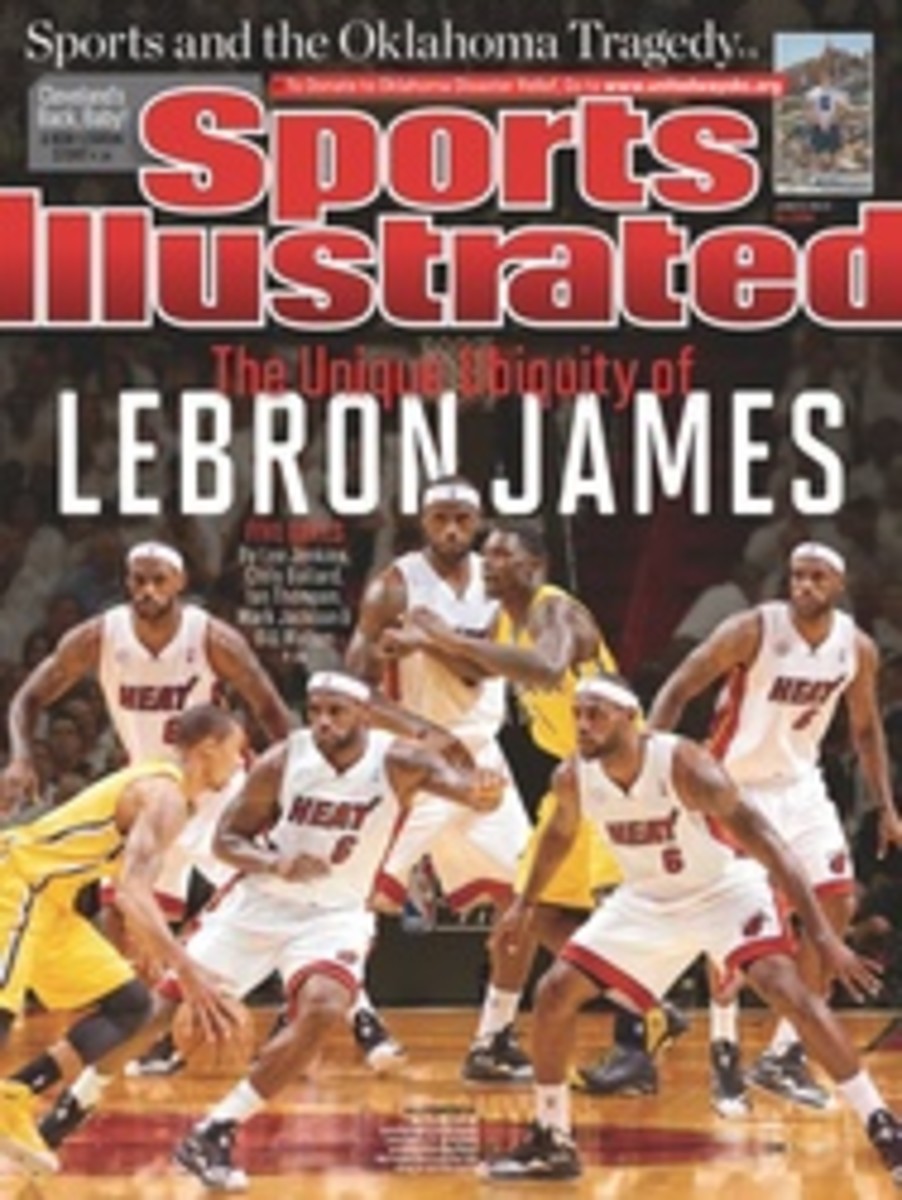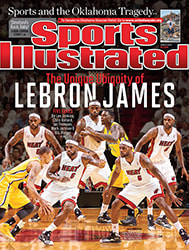
Seeking Shelter
Three days after the tornado, football players from Southmoore High, a five-year-old school on the southern edge of the small central Oklahoma city of Moore, gathered for a team meeting in their locker room. Some sat neatly in rows of folding chairs, others on the floor and still others in the blue metal dressing cubicles that lined the walls. Among the players were at least a dozen of the 22 boys (from more than 170 team members) who had lost their homes in the devastating storm that tore through Moore on the afternoon of May 20, killing 24 and destroying 1,200 residences. At a few minutes past 1 p.m., coach Jeff Brickman entered the room and stood in front of his team. He wore a gray T-shirt, wind pants and knee-high rubber boots, his uniform for the outdoor cleanup detail that would follow the meeting.
Brickman, 36, was born in Moore and graduated from Moore High; when a powerful tornado struck the city on May 3, 1999, he raced home from college at the University of Central Oklahoma in Edmond, ditched his car in stalled traffic by the side of I-35—"Almost like an Armageddon movie or something," he says—and rushed past National Guardsmen to find that his family's home was heavily damaged, but that his parents had heeded warnings and left in advance of the twister. Four years later Brickman's 91-year-old grandmother was pulled alive from the wreckage of yet another tornado that struck Moore. Three major tornadoes have hit the city in Brickman's lifetime; he has an abiding appreciation for the physical and emotional damage they inflict. He also understands that high school football is important in Oklahoma. He watched the annual "Moore War" against crosstown Westmoore High, and last year, his first as Southmoore's coach, he swept the other two city schools en route to a 7--4 season record. His program regularly sends players to Division I colleges. It is a serious business.
But in the immediate aftermath of last week's tornado, Brickman felt a strong impulse to, in his words, "let the dust settle," appropriate phrasing given that the Southmoore grounds were littered with debris from the storm. The last three days of the team's spring practice, including the annual spring game, had been canceled. Yet as he met with players who had lost their homes (one, freshman Taylor Neely, who was not at the meeting, lost his mother), he found something else altogether. They didn't want a break from football. "Every time I met a kid who lost his house, he said to me, 'When can we get back to practice? When can we get back to the weight room?' " says Brickman. "They wanted football so they could get away from the devastation."
He sketched out an ambitious plan to bring the team together the following week for two practices and a spring game that could serve as a fund-raiser and perhaps a healing moment for the community. That plan would ultimately be torpedoed because of onging utility work that caused road closures throughout the area, but in the moment it gave players hope. Here in the locker room, Brickman said to his team, "Raise your hand if you're all in with getting back to football next week." Every hand shot skyward.
An hour after the meeting a stocky junior nosetackle named Bryce Hatton, whose home was destroyed by the tornado, sat among the ruins of what had been a middle-class Moore neighborhood, eating pizza and drinking Powerade handed out by the Salvation Army. Asked why, in the middle of all this, he would keep playing football, Hatton said, "Because football is all I've got now."
The morning of May 20 dawned muggy and breezy in central Oklahoma. "A classic Oklahoma storm situation," says Rick Smith, 49, warning coordination meteorologist for the National Weather Service Forecast Office in Norman, just south of Moore. Tornadoes form prodigiously in Oklahoma along what severe-weather experts call the "dry line," a weather boundary where muggy air from the Gulf of Mexico and dry air from the Southwest are blown together. Smith's office had been targeting May 20 as a potentially dangerous day for nearly a week and by early afternoon had issued severe weather warnings.
Members of the Southmoore football team received midday text messages informing them that the day's 2 p.m. practice had been canceled. Tryouts to find the new mascot—Sammy the SaberCat—remained on the schedule into the early afternoon. Students throughout the school heard that tornadoes were likely, but few remember the 1999 twister and all had lived through countless false alarms. "There's always talk about tornadoes," says senior tight end Brandon Garrison. "I honestly didn't think it would be that big a deal." In place of practice many Southmoore football players met with their coaches and watched film of the previous day's workouts.
At 2:40 p.m. the NWS issued a tornado warning for Moore and neighboring areas—meaning a tornado either has been detected or is imminent. Coaches pulled up angry radar images on cellphones and Smart Boards, giving the warnings substance. The school implemented its tornado protocol: Students were sent by teachers, administrators and coaches to designated areas in the buildings. Sierra Cuccio, a senior cheerleader, says, "We unrolled our cheer mats and stuffed as many people as we could into them, and then rolled them back up." In the fieldhouse, football coaches instructed athletes (mostly football players, but also track athletes and cheerleaders) to don football helmets, move to the center of the building and assume the "tornado position" (hunched over, head between legs).
Sixteen minutes after the initial warning, at 2:56, the tornado touched down 4.4 miles west of Newcastle, about 10 miles from Southmoore High. "The storm went severe very, very quickly," says Smith, the meteorologist. "It was apparent that it was going to be very bad. About as bad as it gets." The tornado would be on the ground for 40 minutes and travel 17 miles in a roughly northeasterly direction, across the middle of Moore. It was an extraordinary 1.3 miles wide, and its winds reached an estimated 210 mph. Based on evidence gathered in the days following the storm, the NWS would classify the tornado as EF-5, the highest possible classification. There have been just 59 tornadoes of that severity in the U.S. in the last 63 years, seven of them in Oklahoma.
Brickman watched the storm approach from behind the school. "It looked like it was going to miss us to the north, then it looked like it was coming right at us," says Brickman. "At the end it looked to the naked eye like it missed us by about 300 yards." (Satellite images indicate that it was closer to 500.) Lane Soltero (a junior) and his younger brother, Drake (an eighth-grader), both defensive backs, were signed out of school by their mother, Angela Maiso, just before the tornado formed. "We were driving while the tornado was on the ground," says Lane. "My mom was flipping out." The storm's largest path of destruction occurred directly north of Southmoore, where it took out Briarwood and Plaza Towers elementary schools and a wide swath of homes.
When it ended, students and families sought to reunite. Sean Jarrell, a freshman linebacker, was in the school cafeteria when a girl from his neighborhood told him that their houses were gone. "My mom was home," says Jarrell, "and I kept thinking the worst." Eventually his position coach, Greg Bryant, received a text from Jarrell's older sister: House is gone. Mom is OK. Junior safety Brandon Dick drove his truck as far as he could, then walked a mile into his neighborhood, where he found his house in ruins. "Tears just started flowing," he says. Players with younger siblings in the flattened elementary schools tried to confirm their safety. Junior Darius Joseph learned that his six-year-old brother, Hezekiah Darbon, was safe at Briarwood, where he had been captured in an already iconic photograph reuniting with a neighbor. Thomas Evey, a freshman wide receiver, discovered his sister, Miranda, in the Plaza Towers parking lot with a gash on her head but safe. Hatton walked more than two miles to Plaza Towers and arrived just as his father got there, and together they came upon Hatton's third-grade sister, Allison, wrapped in a blanket, unhurt. Zac Hernandez, a junior defensive back, walked a mile into his neighborhood but didn't recognize it.
In the days following the tornado, the displaced Southmoore players bounced among friends, family members and hotels. Blake Bills, a sophomore outside linebacker, stayed with four different friends in the first four nights after the storm. Most of the players had to borrow clothing; many spent long hours at the school, accepting supplies from benefactors. Almost all of them felt a deeper affection for their teammates and coaches than before the storm. "Football is the only thing I'm thinking about," said Garrison, 48 hours after the tornado, sitting in Brickman's office with half a dozen fellow SaberCats. "These last couple days, my coaches have shown they would give me the shirt off their back, literally. My teammates are my family. I'm so fortunate to have these guys."
Brickman decided not to let the dust settle. He set up a donations page on the team website from which cash will be distributed every Saturday in equal amounts to every displaced sports family in the school. (Last Saturday, $10,461 was given to 40 families in an emotional ceremony just hours before Southmoore's graduation.) This week Southmoore had hoped to sell T-shirts at Thursday's spring game inscribed with SOUTHMOORE STRONG, with all proceeds going to tornado relief. But with the transportation situation forcing the coaching staff to cancel the planned two-day mini-camp, as well as the game, that plan fell through. The cancellation, however, did little to diminish the unifying force of team. The SaberCats will go together to an Oklahoma City water park on Thursday night and then to the Bill Blankenship Football Camp at the University of Tulsa, beginning on July 5.
Football won't fully rebuild lives. Last Thursday, Southmoore junior Kade Foss, a sturdy left tackle with short blond hair and a scruffy beard, was among eight players who went to the storm zone with an SI writer and photographer. The group stopped at 14708 South Harvey Street, a pile of rubble that was formerly Foss's house. A mattress, a closet door, a battered refrigerator. Piles of shredded wood lay everywhere. Ghostly, skeletal trees dotted the landscape. The scope of the wreckage cannot be captured adequately by television or still images. It is humbling and impossibly sad. "I never thought this could happen," says Foss. His mother, Ginger, rode out the storm in a cabinet underneath the bathroom sink and crawled out of the debris alive. His dog, a two-year-old lab-husky mix named Koda, was killed. "He was my buddy," says Foss. The mention brings tears.
So they will hold on to football, not because it's more important than the lives lost or the lives changed, but because it's a piece of life that's left intact. "It's an escape," says Foss. "It's a chance to put your emotions into something. We're in this together. One big family."
"I KEPT THINKING THE WORST," LINEBACKER SEAN JARRELL SAYS. EVENTUALLY HIS SISTER TEXTED, "HOUSE IS GONE. MOM IS OK."
HOW TO HELP
Football coach Jeff Brickman (left) has established a relief fund for the school's sports families displaced by the storm. To donate, go to the team's website at gosabercats.com
PHOTO
Photograph by BRENNAN LINSLEY/AP
PHOTO
K.O. RINEARSON FOR SPORTS ILLUSTRATED
IN THE PATH OF PERIL The May 20 twister was a mile wide and carrying winds above 200 mph when it hit Moore (circled on radar image), destroying some 1,200 homes, including that of the SaberCats' Lane Soltero (32) and his brother, Drake.
PHOTO
PAUL HELLSTERN/THE OKLAHOMAN/AP (TORNADO)
[See caption above]
PHOTO
WWW.ALABAMAWX.COM (RADAR IMAGE)
[See caption above]
PHOTO
K.O. RINEARSON FOR SPORTS ILLUSTRATED (BRICKMAN)

